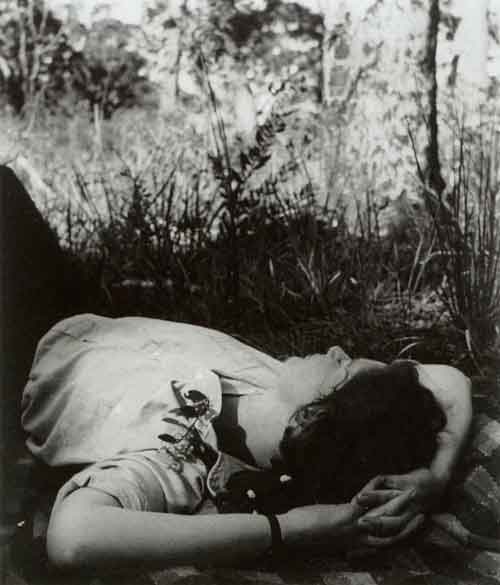SUMMERTIME
Gael Newton
Essay originally published within the NGA's 2000 Catalogue, Federation
By the time Max Dupain made his photograph of a bronzed Aussie sunbaker — now usually described as being a 'quintessentially Australian' image — enjoying life at the beach was very much part of Australia's national psyche as well as its international image.
Dupain described its genesis: on a holiday with friends on the south coast of New South Wales, it was a quick response to seeing a mate flop on the sand after surfing. The spontaneous response fitted Dupain's understanding of the quest for 'actuality' of the documentary movement in film, to record the life of the people.
The photograph is not an amateur's snap, however, and required a professional's camera and skill as well as care in the making of a low-angle view on the sand. Its simple and powerful triangular composition derived from the stripped-down forms of modernism which Dupain had perfected as a style through the previous decade.
Although made in 1937 Sunbaker'was rarely seen before 1975 and did not gain national currency as an icon until the Australian Bicentennial in 1988. Since then it has had many spin-offs, including criticism of its exclusivity in making a fit white male the national symbol.
It is currently a signature image for QANTAS airlines promotions. In 1992, after Dupain's death, it was disappointing to many locals to read in their newspapers that the sun-bronzed subject, Harold Salvage, was actually a 'Pom'.
Despite its simplicity, Sunbaker is a complex image — the tight design and strong body speak of introspection and isolation as much as hedonism under a southern sun.1
Sleeper 1939, Olive Cotton's graceful study of her friend Olga Sharp resting while on a bush picnic, made around the same time as Dupain's Sunbaker, presents a different take upon the enjoyment of life in Australia.
The woman is relaxed, receiving the soft caress of warmth and sunlight, nestled within the environment rather than silhouetted and highlighted. Her open languid position also speaks of the woman's freedom in her environment.
The mood is one of secluded reverie, with no reference to the long-established tradition in the arts of depictions of the lady in repose, merely waiting male attention.2 |
|
 |
| |
Photo 1: Max Dupain Sunbaker 1937, printed c.1975, gelatin silver photograph 38.6 x 43.4cm, National Gallery of Australia
Photo 2: Olive Cotton, The Sleeeper 1939, printed 1975, gelatin silver photograph, 29.2 x 25.0 cm, National Gallery of Australia
notes
- For the background to the making of Sunbaker see Gael Newton. 'The Sunbaker', in Jill White, Dupain's Beaches, Sydney: Chapter and Verse, 2000, pp. 68-73.
- See Helen Ennis, Olive Cotton, exhibition catalogue, Sydney: Art Gallery of New South Wales, 2000
Gael Newton
more of Gael Newton's Essays and Articles
|